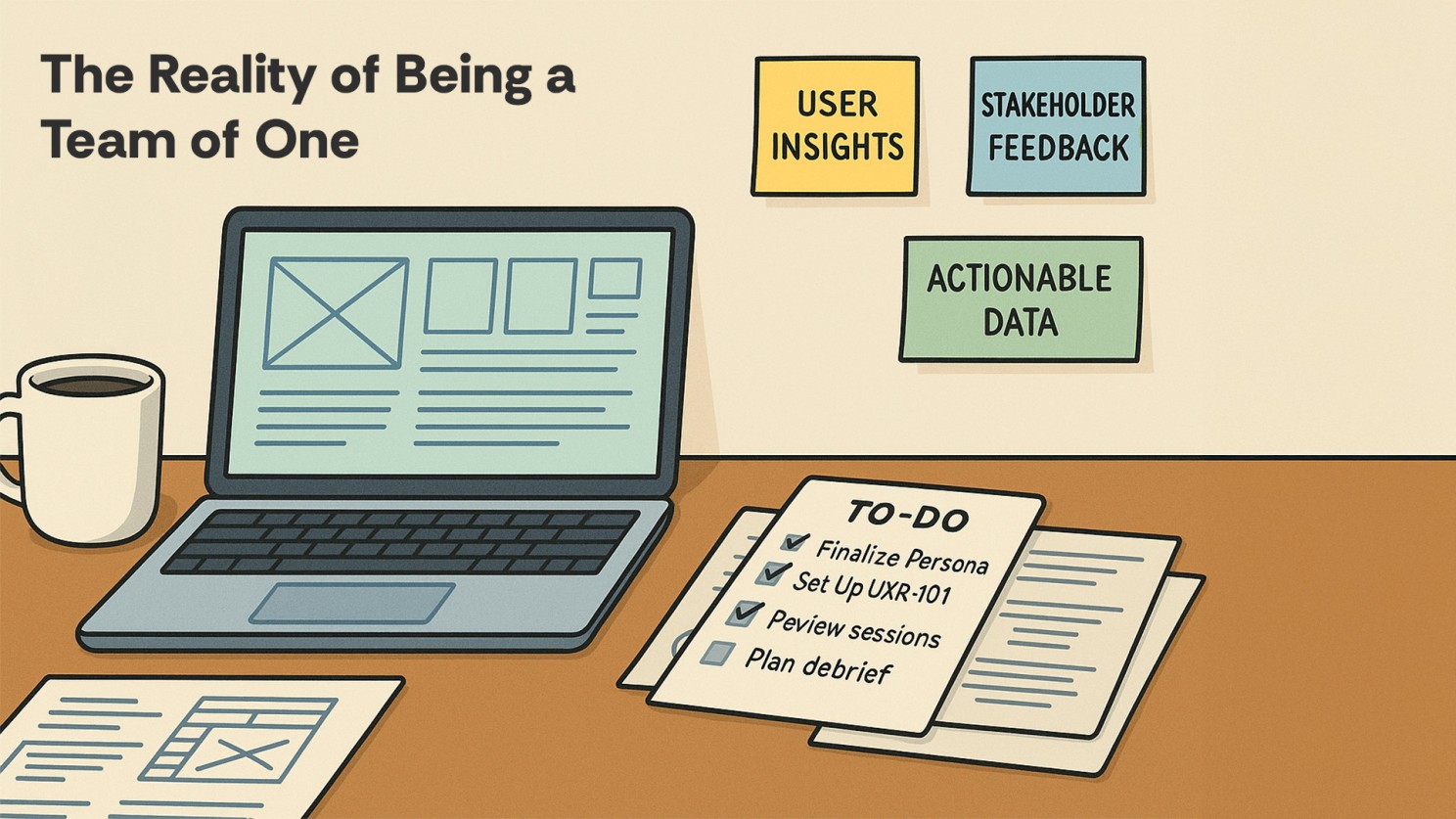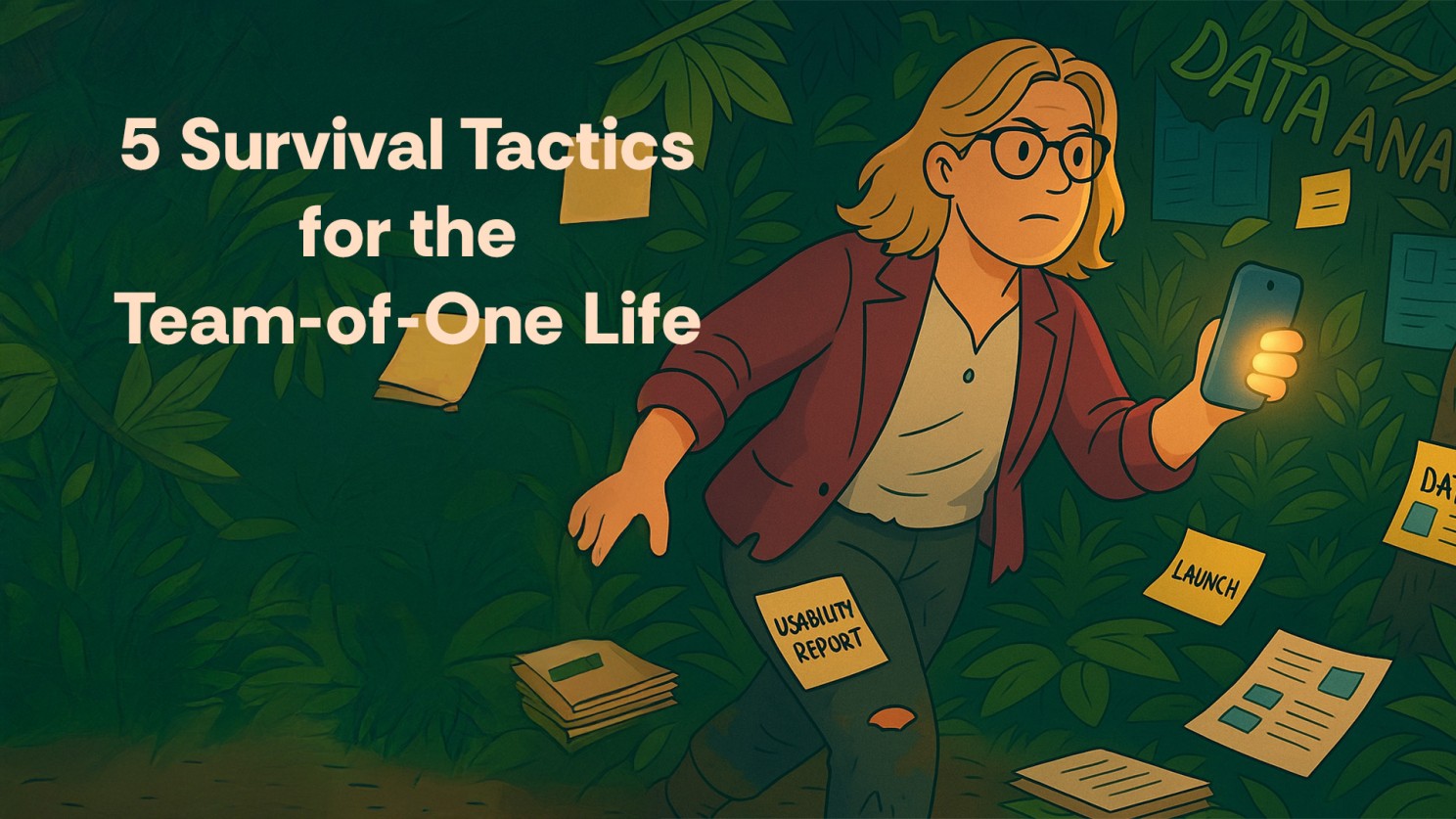
How to stay sane, scale insights, and make an impact when you’re the entire UX research department.
When you’re the only UX researcher on the team, you’re not just wearing all the hats—you’re stitching them together with duct tape and prayer.
Being a team of one can sound empowering in theory. You get autonomy, freedom, and the thrill of shaping the research function from scratch. But in reality? It often means working across multiple time zones, saying “yes” to everyone because there’s no one else to pass the request to, and trying to explain—again—that no, a single open-ended survey is not a usability test.
In this article, I share the hard-won tactics and mental frameworks that have helped me stay focused, make an impact, and avoid burnout as a solo UX researcher. Whether embedded in a nonprofit, faith-based organization, or fast-moving team, this is for anyone navigating the balance between limited resources and high expectations.
Let’s get into it.

The Reality of Being a Team of One
There’s a certain mystique around being the “only UX researcher.” It sounds cool on paper—like you’re a rogue insight-gatherer parachuting with notebooks and frameworks, ready to transform the organization one user interview at a time.
But here’s what it actually looks like most days:
- You’re switching between usability testing, stakeholder meetings, and tagging open-text user responses… all before lunch.
- You’re in meetings where you’re expected to advocate for research, conduct the study, and magically have the final report done by the close of business.
- You’re the research planner, implementor, moderator, analyst, and slide deck wrangler—all in one.
There’s no one to gut-check your scripts, no second pair of eyes on your scenarios and questions, no one to say, “Hey, this insight is solid—send it.” You are the process, the person, and the pressure.
While that can feel empowering at times, it’s also draining. The cognitive load is real, and so is the emotional labor—mainly when you’re constantly translating the value of research to people who aren’t quite sold on why it matters yet.
This isn’t about complaining but acknowledging the invisible labor that comes with the role. Because when we name it, we can actually start to manage it.

So, how do you keep your sanity, scale your impact, and avoid burning out when you’re the only person doing the work?
Here are five tactics that have helped me survive (and sometimes even thrive) in solo UX research mode:
1. Prioritize Like a Product Manager
When everything is “important,” nothing is. Protect your time by treating research requests like product features—use an impact/effort filter. If they won’t significantly benefit the business or users, it’s okay to push back or postpone.
Pro tip: Implement a simple intake form to ensure stakeholders clearly articulate their goals before you proceed.
2. Standardize or Suffer
Templates are your lifeline. Scripts, research plans, report formats—anything you find yourself rewriting more than twice should become a reusable document. Standardizing your process reduces mental load and keeps things moving even on your busiest weeks.
Bonus: A clear structure makes it easier to scale or hand off later if your team grows.
3. Use AI and Automation as Force Multipliers
You’re only one person, but AI tools can help extend your reach. I’ve used ChatGPT to summarize open-text responses, reframe insights for different audiences, and even get a rough draft of a stakeholder-friendly report.
It’s not about replacing your thinking—it’s about speeding up the grunt work so you can stay focused on strategy and storytelling.
4. Tell the Story, Not Just the Stats
Research only makes an impact when it’s heard. That means packaging insights in ways that resonate. Sometimes it’s a 3-slide summary. Other times, it’s a quick walkthrough. The key is clarity, not complexity.
Think: What’s the one sentence I want my stakeholders to remember?
5. Find Your UX Research Village
Even if you’re the only researcher in your organization, you don’t have to operate in a vacuum. Online communities, Slack groups, mentoring circles—these spaces are invaluable for gut checks, tool recommendations, or just hearing “same.”
You’re not alone. It just feels that way sometimes.

What I Wish I Knew Earlier
No one tells you how lonely this role can feel.
When you’re the only researcher, there’s no one to sanity-check your insights or share the win when a study leads to a breakthrough. You’re making judgment calls constantly—sometimes on things you’ve never done—and hoping your gut (plus a few Google searches) leads you in the right direction.
If I could go back and tell myself a few things earlier in my career, it would be this:
- You don’t have to prove your worth on every project. Not every research plan has to be a masterpiece. Good enough is often more than enough—especially when working across multiple priorities.
- Boundaries are not optional. When you say yes to everything, your work (and your well-being) both suffer. Learning to say, “I can’t do that right now, but here’s what I can offer,” is a skill—and a gift.
- Visibility is part of the job. You can’t assume people understand your impact. Make it visible. Share wins, summarize feedback, highlight when research led to action—even if it feels like you’re stating the obvious.
- It’s okay to ask for help. Don’t be afraid to reach out, whether it’s a mentor, a professional group, or a peer you admire. Some of the best advice I’ve received started with a simple DM.
Being a team of one doesn’t mean doing everything alone. It just means being intentional about where you spend your time, energy, and creativity.
Final Thoughts: You’re Not Alone in This
If you’re the only UX researcher on your team, you do more than your job description could ever capture. You’re advocating, experimenting, translating, and probably working with fewer tools and less time than you’d like.
But here’s the good news: You don’t need a big team to make a significant impact.
You need a process that protects your energy, tools that scale your thinking, and a mindset that sees “scrappy” as a strength—not a weakness.
If this resonated with you, I’d love to hear:
- What’s your #1 survival tip for being a solo researcher?
- Or: What’s one thing you wish you’d known earlier?
You can drop it in the comments or send me a message. You don’t have to do it alone.
